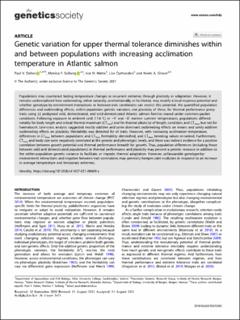| dc.description.abstract | Populations may counteract lasting temperature changes or recurrent extremes through plasticity or adaptation. However, it remains underexplored how outbreeding, either naturally, unintentionally, or facilitated, may modify a local response potential and whether genotype-by-environment interactions or between-trait correlations can restrict this potential. We quantified population differences and outbreeding effects, within-population genetic variation, and plasticity of these, for thermal performance proxy traits using 32 pedigreed wild, domesticated, and wild-domesticated Atlantic salmon families reared under common-garden conditions. Following exposure to ambient cold (11.6 °C) or ~4° and ~8° warmer summer temperatures, populations differed notably for body length and critical thermal maximum (CTmax) and for thermal plasticity of length, condition, and CTmax, but not for haematocrit. Line-cross analysis suggested mostly additive and some dominant outbreeding effects on means and solely additive outbreeding effects on plasticity. Heritability was detected for all traits. However, with increasing acclimation temperature, differences in CTmax between populations and CTmax heritability diminished, and CTmax breeding values re-ranked. Furthermore, CTmax and body size were negatively correlated at the genetic and phenotypic levels, and there was indirect evidence for a positive correlation between growth potential and thermal performance breadth for growth. Thus, population differences (including those between wild and domesticated populations) in thermal performance and plasticity may present a genetic resource in addition to the within-population genetic variance to facilitate, or impede, thermal adaptation. However, unfavourable genotype-by-environment interactions and negative between-trait correlations may generally hamper joint evolution in response to an increase in average temperature and temporary extremes. | en_US |
